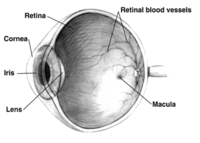
Photo from wikipedia
PURPOSE To compare different scan protocols of wide field swept-source optical coherence tomography angiography (SS-OCTA) for the detection of diabetic retinopathy (DR) lesions. DESIGN Comparison of diagnostic approaches. METHODS A… Click to show full abstract
PURPOSE To compare different scan protocols of wide field swept-source optical coherence tomography angiography (SS-OCTA) for the detection of diabetic retinopathy (DR) lesions. DESIGN Comparison of diagnostic approaches. METHODS A prospective, observational study was conducted at Mass Eye and Ear from December 2018 to July 2019. Proliferative diabetic retinopathy (PDR), non-proliferative diabetic retinopathy (NPDR) and diabetic patients without DR were included. All patients were imaged with a SS-OCTA using following scan protocol: Angio 3mm×3mm centered on fovea, Angio 6mm×6mm centered on fovea and optic disc, Montage 15mm×9mm and Angio 12mm×12mm centered on fovea and optic disc. Images were independently evaluated by two graders for the presence or absence of DR lesions including microaneurysms, intraretinal microvascular abnormalities, neovascularization, nonperfusion areas, venous looping and hard exudates. All statistical analyses were performed using SPSS 25.0. RESULTS One hundred and seventy-six eyes in 119 participants were included in the study. The detection rate of neovascularization on Angio 6mm×6mm centered on fovea was about half of that on Montage 15mm×9mm(P<0.05). Combining Angio 6mm×6mm centered on fovea and optic disc could increase the rate to about two thirds (P<0.05). The Angio 12mm×12mm centered on the fovea and optic disc scan combination had comparable detection rates to Montage 15mm×9mm for all DR lesions (P>0.05). For microaneurysms, Angio 6mm×6mm had better performance than Montage 15mm×9mm (P<0.05). CONCLUSIONS Wide field SS-OCTA images were useful in detecting DR lesions. The Angio 12mm × 12mm centered on fovea and optic disc may be an optimal balance between speed and efficacy for DR evaluation in clinical practice.
Journal Title: American journal of ophthalmology
Year Published: 2020
Link to full text (if available)
Share on Social Media: Sign Up to like & get
recommendations!